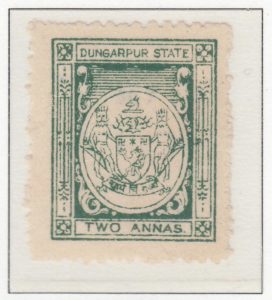
Population 100,103 (in 1901)
Dungarpur was a Princely state in the Rajput Agency in northwestern India (presently part of the state of Rajasthan). Maharajadhiraja Maharawal Lakshman Singhji ruled from 1918-89, issuing the first stamps from 1933-47.
Both Stanley Gibbons and Scott list eight stamps as constituting the first issue. They were lithographed, gummed and perforated 11. The issuance of these stamps was unknown to philately until more than 20 years from their initial date of issuance. Thus, even though the stamps are relatively modern, mint examples are extremely rare.
Click here to see all stamps from Dungarpur in this exhibition.
History
A rightful heir somehow dispossessed is an old story – and this is the story of Dungarpur. Dungarpur was founded in 1197 and ruled by the elder branch of the Sisodiyas of Udaipur, whose younger branch rules Mewar, a more extensive and important territory. Several stories exist: A Mewar rightful heir waiving his birthright and setting out to seek his own fortune, an heir dispossessed of his rightful bride by his father; an heir refusing to murder his younger – by an hour – brother, and an heir jealous of a conquering younger brother. In any case, the rightful heir left his ancestral lands and settled in the territory of Dungarpur, his mother’s homeland. This ruler, and several after him succeeded in curtailing the power of the ruling Bhil (tribal) chiefs.
The town of Dungarpur, capital of the region, was also founded in conflict. In the late 1300s, Dungaria, a Bhil chieftain in control of the town, sought to marry the daughter of a wealthy merchant. A date was set, but the future father-in-law and the ruler of the state assassinated the prospective bridegroom and his party while they were drunk. The ruler of the state then seized the Bhil territory. Later he renamed both the state and the city “Dungarpur,” in memory of the victim of his misdeed, Dungaria, and as a symbol of restitution.
A relatively small state, Dungarpur was subject to the Mughals and the Marathas at various points. Dungarpur became a Raj princely state when it entered an agreement with the British East India Company in 1818, which included tribute. In 1948, it became part of the Indian state of Rajasthan.
Although no longer officially royal, old traditions die hard, and royalty of the (former) Princely Indian States continue to intermarry in fabulously lavish events. A 2015 BBC article chronicles the nuptials of Princess Shivatmika Kumar of Dungarpur, including a five-mile procession of 5,000 people, with 30 princes, camels, and elephants. The prince is carried, seated in a gold throne, on an elephant. The week-long festivities are held in a 100-room palace. Like many of India’s former royal families, these people have enriched themselves through the opportunities afforded by a growing economy. The match was arranged by parents, and bride and groom have met only briefly. The bride was interviewed, covered from head to toe with a red veil. The groom is western-educated; the bride has a degree in psychology. Unlike many of the women descended from Indian royalty, she intends to work.
Dungarpur
1933-1947

1/4 Anna
Bister Yellow

1 Anna
Pale Turquoise Blue

2 Annas
Deep Dull Green